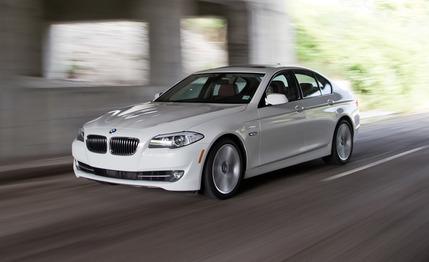
 Long-Term Road Test Wrap-Up
Long-Term Road Test Wrap-Up


The vast majority of long-term cars we order come loaded with all the newest and hottest options, sometimes with a blatant disregard for the bottom line. This, we freely admit, could be considered juvenile. But it gives us the ability to report on whether or not that $4000 list of interior trimmings is actually worth it.
This is not one of those cases. We wanted to get a jump on testing a new F10 535i sedan so badly that BMW let us choose from a selection of previously ordered vehicles. At the high end were 5ers costing close to $70,000. At the absolute low end was this white 535i with a manual transmission and the Sport package ($2200), Dynamic Handling package ($2700), a $400 iPod connector, and cinnamon-brown Dakota leather seats ($1450). Grand total: $57,225. On paper, we were drawn to its simplicity. We thought that this might be the kind of 5-series we would spec out were we to actually purchase one. One of the many lessons learned at the Bay of Pigs is that theory is often at odds with reality.
In the logbook’s first entry, associate online editor Jon Yanca set the tone for this car’s tenure: “I know everyone will complain about the lack of navigation, heated seats, and satellite radio.” Sure enough, entry after entry complained endlessly of cold seats and the cheap non-navigation iDrive display that resembles an old cathode-ray tube more than a modern LCD flat screen. Most 5 drivers were not aware that the Cold Weather package, and its heated seats, was not available at launch. No matter—we were resentful that a nearly $60,000 car had our backsides making their own heat on chilly mornings.
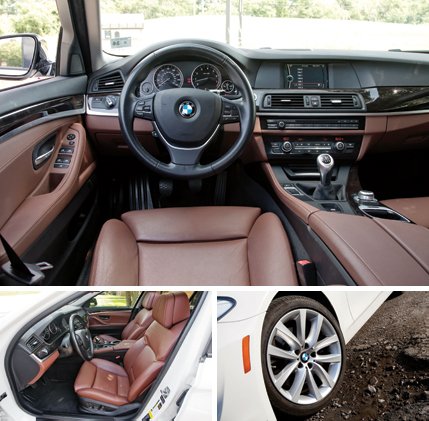

The 535i’s spartan mien did not stop it from becoming an instant long-haul favorite, however. Never mind the car’s shortcomings—numb steering, disappointing handling composure, and a hefty curb weight—that left it behind the Audi A6 and an Infiniti M37 in a comparison test [August 2010]; its odometer rolled past 20,000 miles in less than five months while visiting locations such as Myrtle Beach, Yellowstone National Park, and the Great Smoky Mountains. Editor-at-large John Phillips was one of many to commend the 535i for terrific interstate behavior, calling it “serene, composed, and quiet.” Yeah, that, and it was not unusual to hit 28 mpg on an interstate stretch. We averaged an impressive 23 mpg over 40,000 miles.


Phillips was on a solo trip; had he been driving two-up, he surely would have noticed the dearth of cup holders fitted in the manual 535i. Automatic-equipped 5-series cars have a pair of cup holders just in front of the gear selector. For the sake of clearance, manual versions dump the cup holders for a small bin and a short, three-quarter round cup bolster hidden beneath the passenger’s half of the center armrest, leaving just one exposed beverage stabilizer that deploys at the push of a button. It’s not able to meet a Big Gulp on its own terms.
Now, enough with the frippery and onto the durability portion of this test. Early in its stay with us, when the car’s odo turned past 9000 miles, we discovered a bubble in the sidewall of the right-front Goodyear. It was the first of many wheel and tire expenses we incurred. The bulging tire was replaced for $447—more on that in a minute.


The first of two scheduled services, as determined by the 535i’s onboard computer and covered by BMW’s scheduled maintenance program, came in fall 2010 at roughly 19,000 miles. During it, BMW of Ann Arbor performed an oil change and some inspections; attended to a couple of recalls (a potentially faulty fuel-level sensor and new trunk trim that required a second trip to the dealer for installation); and also replaced (under warranty) a door-lock tab that went MIA.
After the 535i spent the winter months on Bridgestone Blizzak LM-60s, our local tire installer found that the right-rear wheel was severely bent, thus adding a $595 line item to the 5-series books at 32,000 miles.
It was at roughly this time that we started to notice the onset of automotive middle age. A few creaks and rattles but nothing alarming. Senior editor Tony Quiroga thought the engine never fully loosened up and that it continued to exhibit a bit of turbo lag when compared with other turbo sixes from BMW. His subjective feelings were contradicted by our track results, in which the 535i improved its end-of-test 0-to-60-mph and quarter-mile times by 0.1 second, to 5.7 and 14.2, respectively.
No money would exchange hands at the next service visit, it of the unscheduled variety, when the dealer repaired the console-mounted cup holder and replaced the HVAC control face because a few of the instructional pictograms on its buttons had worn off. In the past with other cars, we have paid for a cup-holder repair: Both of the above warranty items are a testament to the BMW 4-year/50,000-mile assurance. Company reps have told us that the only thing owners of new BMWs need to think about paying for during that time period is tires. To that very short list, we add wheels.
Around the 33,000-mile mark, the front tires were on their wear indicators, so we replaced them ($894) and discovered another bent wheel ($581). Then, 2000 miles later, after many observations by staffers about harsh suspension noises and vibrations, we asked the dealer to investigate. The service department said our car’s suspension and its bushings were just fine but the left-rear wheel and both of the fronts were bent. Plus, one of those 2000-mile-old front tires suffered an impact failure (likely at the same time the wheels were dented).
There was no way around spending another $447 on a front tire. In lieu of replacing three wheels to the tune of about $1750, we employed Alloy Wheel Repair Specialists to straighten three wheels for $405.
The second of two scheduled stops—oil change and inspections—came and went at 38,000 miles without breaching our wallet.
Right at the end of the test, at 40,000 miles, the rear tires were also at the end of their lives (after being shelved for 10,000 miles during the winter months) and needed to be replaced ($970). The dealer looked into what we thought was abnormal tire wear and charged us $134 for the inspection and $210 for an alignment. The closer look also revealed yet another bent front wheel ($135 tossed Alloy Wheel Repair Specialists’ way).
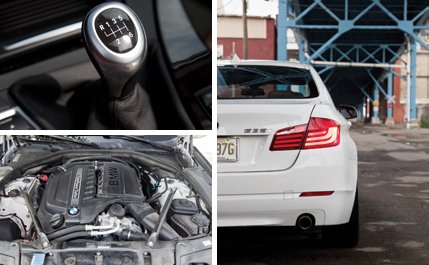

To recap: While the 535i was with us, we replaced two wheels (one front, one rear) and six tires (four worn, two damaged), and we repaired four wheels. The total bill for this, not including installation (which runs $163 for a full tire swap): $4474. We would have saved some cash had we purchased the 535i from a dealership and been upsold on the new BMW Tire & Wheel Protection program ($1389 for five years for a 5-series) because a $50 deductible covers replacement wheels and tires.
If it were not for the wheel and tire problems, the 535i would have finished its C/D tour of duty with very few strikes against it, one being that it was too thin in the options department. This was our fault—we underestimated how truly soft we’d become. But it’s a 5er that a hardier soul, or one who lives in a warm state, would buy.
The bigger problem is that, while the F10 535i gained 193 pounds and maintained its 51/49-percent weight distribution, its wheels weren’t beefed up for the extra 100 pounds carried by the front axle. Our first wheel specialist saw it right away: The wheels are soft. If you do find yourself in the market for a 535i like this one, a word of advice: Avoid potholes. That ought to be easy enough in a climate where you don’t need heated seats.
Wheelman
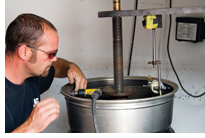

After replacing two of our BMW’s wheels at a cost of about $600 each, we investigated more affordable solutions and found Alloy Wheel Repair Specialists (AWRS). The company’s wheel repairmen make house calls. Call ’em up, and someone will come to your home or place of business and get to work fixing dents or curb rash. The process is surprisingly simple. The wheel is mounted on a vertical axle (similar to a tire-mounting machine), with or without a tire. After cleaning the wheel, the repairman measures it with a dial indicator to mark the low spots. Depending on the size of the deformation, the AWRS specialist might use a propane torch to soften the metal before employing a 10,000-psi ram to bring the wheel back to round, or close enough to successfully balance. If a wheel impact deforms the outer spokes, this company can’t repair the wheel. We called AWRS twice. The first repairman commented on how soft the 535i’s wheels are, but the second said he’d seen softer. We were charged $135 per wheel, but prices vary. Curb-rash repair starts at $125. And the company will even paint a wheel on-site. (800-518-3040; www.awrswheelrepair.com).
Aftermarket Navigation
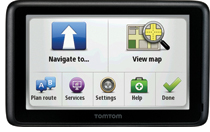

As noted, our scantily optioned 535i lacked the comforts we’ve come to expect in luxury cars, such as an in-dash navigation system. With the prevalence of smartphones, a dedicated nav system may seem unnecessary. But, as we found in central Wyoming, having a navigation device that doesn’t require cellular service to download a map can save time, fuel, and sanity. At $280, the TomTom Go 2505 TM is in the upper-middle-class range of the portable-nav market. For the lifetime of the unit, it comes with map updates and traffic information. The touch-screen interface is logical, and you can customize the voice with a host of celebrity, cartoon, or movie-inspired themes. We went with Homer Simpson—$13 well spent. We had a little trouble getting the unit to sync with our computer when we wanted to install map updates or the custom voice. But once we worked out the bugs, it was trouble-free. (866–486–6866; www.tomtom.com).